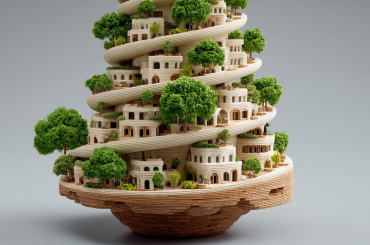Standing on my tiny Bristol balcony last spring, staring at the concrete walls and desperately craving some greenery, I had what can only be described as a vertical gardening epiphany. The space was barely large enough for a chair and small table, but those blank walls stretched upward with untapped potential. That’s when I stumbled across the concept of vertical garden using pallets, which seemed like the perfect solution for someone with maximum plant enthusiasm and minimum horizontal space. Six months later, my balcony has been transformed into a thriving vertical oasis that produces herbs, flowers, and even some vegetables—all thanks to a couple of discarded wooden pallets and a lot of trial and error.
The journey began with research that proved surprisingly complex. Not all pallets are created equal, and some are treated with chemicals that make them unsuitable for growing edible plants. I learned to look for pallets marked with “HT” (heat treated) rather than “MB” (methyl bromide), which took considerably more hunting than I’d anticipated. After visiting several local businesses and explaining my vertical gardening project to bemused warehouse managers, I finally secured two properly treated pallets from a garden center that was happy to see them reused rather than discarded.
The preparation phase taught me patience and attention to detail. Cleaning pallets thoroughly involves more than just hosing them down—years of warehouse use had embedded dirt, oil stains, and the occasional mysterious sticky substance that required serious scrubbing with biodegradable soap. Sanding came next, which proved essential for both safety and plant health. Those rough wooden surfaces needed smoothing to prevent splinters while creating better contact points for the landscape fabric that would hold soil and plants in place.
Creating the actual vertical garden from pallets required more engineering thinking than I’d expected. The landscape fabric serves as both soil barrier and water management system, and getting the tension right took several attempts. Too loose, and soil would spill everywhere; too tight, and drainage suffered. I learned to cut the fabric slightly larger than needed, pull it taut across the back of the pallet, and staple it securely while leaving strategic drainage points at the bottom to prevent waterlogging.
Soil selection became crucial for vertical gardening with pallets because traditional garden soil proves too heavy and doesn’t drain properly in vertical applications. After consulting with local garden center staff and conducting some small-scale experiments, I settled on a lightweight potting mix amended with perlite for drainage and compost for nutrients. The soil needs to stay put while allowing water to move through rather than pooling in the pockets created by the pallet slats.
The best plants for vertical pallet garden turned out to be quite different from what I’d initially imagined. My romantic visions of trailing flowering vines gave way to practical reality about weight distribution, water requirements, and maintenance accessibility. Succulents proved ideal for their low water needs and shallow root systems. Herbs like rosemary, thyme, and oregano thrived in the well-draining conditions while providing actual culinary value. Small ferns added lush greenery, and strawberry plants created lovely cascading effects while producing edible fruit.
Installation presented the most nerve-wracking moment of the entire project. Vertical garden pallets filled with soil and plants weigh significantly more than empty wooden frames, and proper mounting became essential for both safety and plant survival. I invested in heavy-duty wall brackets designed for outdoor use and enlisted my neighbor’s help for the actual mounting process. The pallet needed to be completely filled and planted before installation, which meant maneuvering a heavy, delicate structure into position without disturbing the carefully arranged plants.
Watering strategies required complete rethinking of normal gardening approaches. Water naturally flows downward through vertical garden using pallets, which means plants at the bottom receive more moisture than those at the top. I learned to water slowly from the top, allowing time for soil absorption before adding more water. During hot summer months, this meant daily watering in the early morning to prevent afternoon evaporation. A small watering can with a narrow spout proved essential for precise application without washing soil out of the individual planting pockets.
The maintenance routine evolved through observation and occasional plant casualties. Some herbs grew more vigorously than expected and needed regular trimming to prevent overwhelming smaller plants. Dead leaves required prompt removal to prevent pest problems and maintain appearance. Fertilizing became a monthly ritual using diluted liquid fertilizer applied during regular watering to ensure even distribution throughout the vertical structure.
Seasonal changes taught me about the dynamic nature of vertical gardening with pallets. Spring brought explosive growth that required frequent pruning and harvesting. Summer heat stressed some plants while others thrived, leading to strategic replacements and learned lessons about plant selection. Autumn provided opportunities to plant cold-hardy herbs and remove heat-sensitive species. Winter required protection strategies including moving the entire structure to a more sheltered location during particularly harsh weather.
The community response to my vertical garden pallets was overwhelmingly positive and sometimes resulted in unexpected social interactions. Neighbors stopped to ask questions about construction methods and plant choices. Several people mentioned they’d been inspired to start their own vertical gardening projects, creating an informal network of urban gardeners sharing tips and experiences. The local garden center where I’d sourced the pallets asked for photos to display as an example of creative reuse projects.
Pest management in vertical gardens presented unique challenges and opportunities. The elevated position and good air circulation helped prevent many soil-borne problems that affect ground-level gardens. However, aphids occasionally discovered my herbs, requiring vigilant monitoring and intervention with organic treatments like neem oil spray. Beneficial insects had difficulty accessing the vertical garden, so hand-picking pests and encouraging natural predators through companion planting became essential strategies.
The productivity of my upcycle pallets garden exceeded all expectations. A single pallet provided enough herbs to meet most of my cooking needs throughout the growing season. Fresh basil, parsley, cilantro, and chives were always available just outside my kitchen door. The strawberry plants produced small but intensely flavored fruit perfect for morning smoothies. Even the ornamental plants served practical purposes by attracting beneficial insects and creating privacy screening for the balcony.
Cost analysis revealed that vertical garden using pallets offered excellent value compared to purchasing equivalent amounts of fresh herbs and flowers throughout the year. The initial investment included pallets (free), landscape fabric (£15), soil and amendments (£30), plants (£50), mounting hardware (£25), and tools (£20), totaling roughly £140. Within six months, the herb production alone had offset the initial costs, while the flowers and strawberries provided additional value that couldn’t be easily quantified.
Creative adaptations developed as I gained experience with the system. Adding a simple drip irrigation system made watering more efficient during holiday periods. Painting the wooden pallet frame with eco-friendly wood stain improved weather resistance while adding visual appeal. Installing small LED strip lights created dramatic evening ambiance while extending growing season for some plants during shorter winter days.
The educational value proved as significant as the practical benefits. Learning about plant compatibility, soil drainage, weight distribution, and vertical growing techniques provided knowledge applicable to many other gardening situations. Understanding how different plants respond to vertical growing conditions improved my overall gardening skills and confidence in trying new approaches to food production and ornamental gardening.
Space efficiency became the most compelling argument for vertical gardening with pallets in urban environments. My small balcony now supports roughly forty individual plants in the space previously occupied by a single large pot. The vertical arrangement creates layers of visual interest while maximizing photosynthetic capacity per square foot of floor space. This approach could easily scale up for larger walls or scale down for even smaller spaces like apartment windowsills.
Environmental benefits extended beyond just plant production to include waste reduction, carbon sequestration, air purification, and habitat creation for beneficial insects. The pallets that might have ended up in landfill now support thriving ecosystems that contribute to local biodiversity while producing food and medicine. Each plant in the vertical garden actively improves air quality while providing psychological benefits through connection to natural growing processes.
Future expansion plans include creating additional vertical garden pallets for different microclimates around my small outdoor space. A shadier location could support ferns and moss gardens, while a sunnier spot might accommodate tomatoes or peppers in larger pockets. The modular nature of pallet construction allows for experimentation with different configurations and plant combinations without major infrastructure changes.
Looking back on six months of vertical gardening using pallets, the transformation of my urban balcony represents much more than just space-efficient plant growing. It’s demonstrated how creative problem-solving can turn limitations into opportunities while building practical skills and community connections. The daily interaction with growing plants has improved my mental health and provided ongoing satisfaction through both harvest and aesthetic enjoyment.
My journey proves that community gardens concepts can be adapted to the smallest urban spaces through innovative approaches like vertical pallet gardens. What started as a response to spatial constraints has become genuine enthusiasm for sustainable urban agriculture that anyone with access to a wall and some basic tools can implement successfully.
The project continues evolving as I discover new plants suitable for vertical growing, refine watering and maintenance techniques, and connect with other urban gardeners experimenting with similar approaches. Each season brings opportunities to improve the system while enjoying fresh herbs, flowers, and the satisfaction of growing food in previously unused urban space. Sometimes the best sustainable living solutions emerge from combining creativity with constraint, turning limitations into innovations that improve both personal wellbeing and environmental health.




